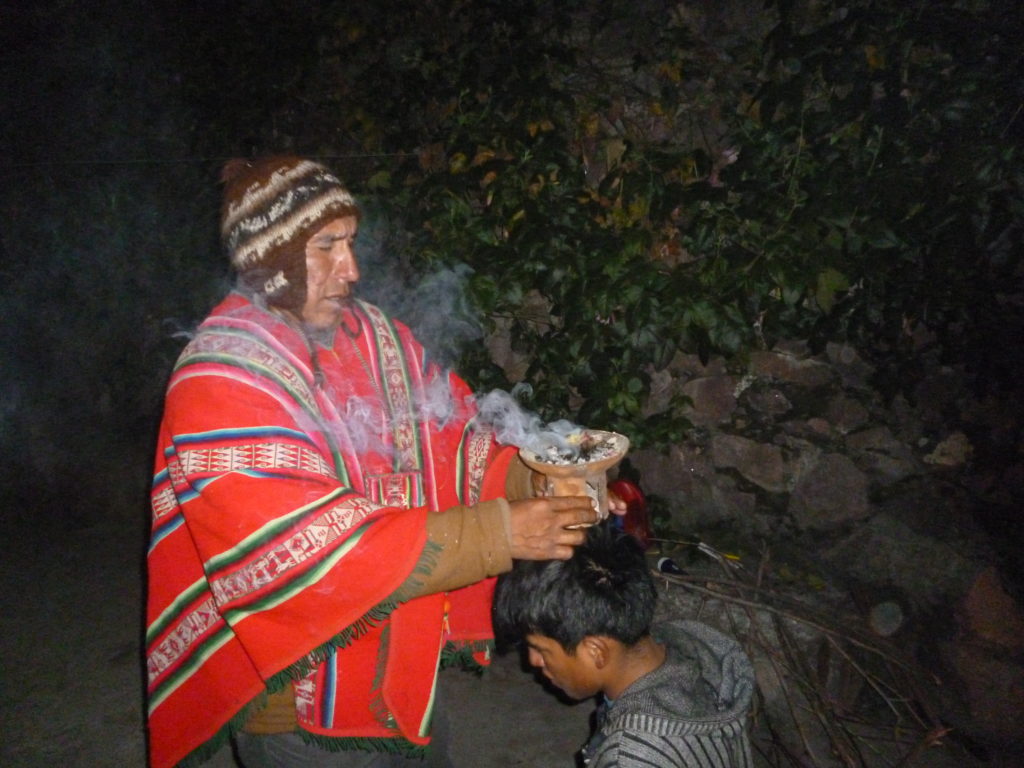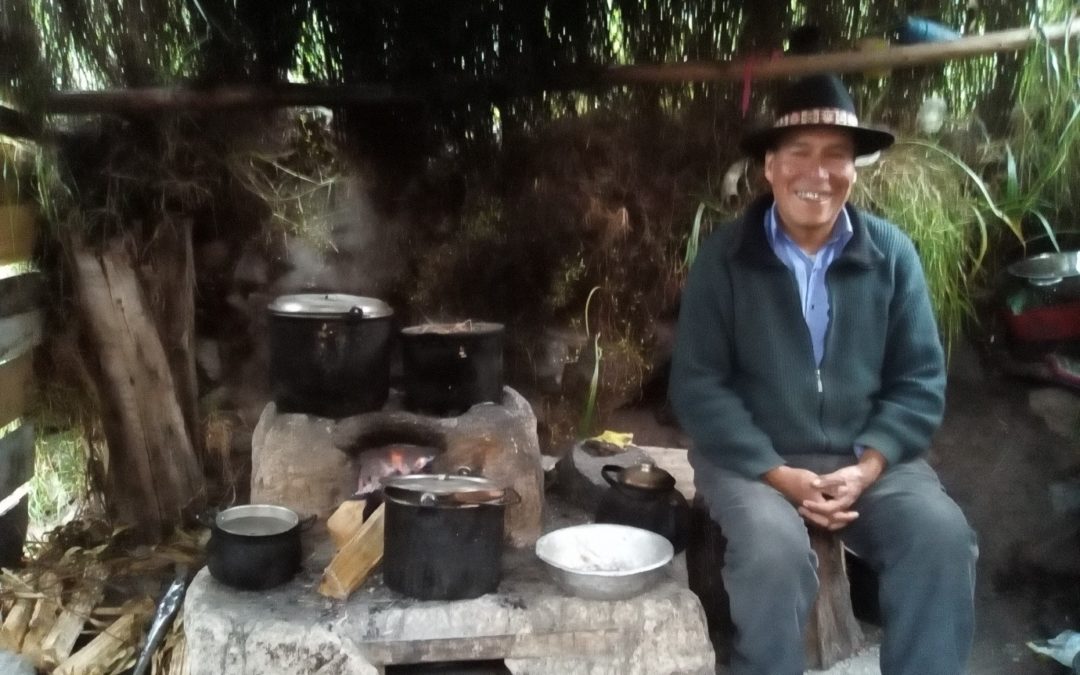By Jonathan Alderman (ILAS)
Professor Ina Rösing, anthropologist and psychiatrist, who for many years worked at the University of Ulm in Germany, passed away on the 7th of December 2018. She was 76 years old. From 1990 to 2008, Ina Rösing wrote extensively on the Kallawayas, an indigenous nation in the northwest of Bolivia known particularly for their profession as healers. Her research on the Kallawayas has been published in over a dozen monographs in both Spanish and German (several of which are also available in English). She also conducted research with healers in Tibet. As Ina Rösing explains in the prologue to her books, she came to study the Kallawayas as a psychiatrist in order to understand the symbolic healing of the Kallawayas. In her books she describes and analyses in extraordinary detail a wide range of Kallawaya rituals. These are a vital reference point for anyone researching the Kallawayas today. I learned of her passing in January 2019 through two of her former PhD Students, Dr Esther Balboa and Dr Jose Antonio Rocha, who live and work in the Bolivian city of Cochabamba. Dr Rocha’s obituary (in German) of Ina Rösing can be read here: https://www.uni-ulm.de/universitaet/hochschulkommunikation/presse-und-oeffentlichkeitsarbeit/pressemitteilungen/meldungen-vom-campus/nachrufe/nachruf-auf-prof-ina-roesing-am-7122018/
Though I never met Ina Rösing personally, during my own research in the Kallawaya region, I became aware of the esteem in which she is held, and the fond memories that Kallawayas themselves, in various different communities, have of her, ever since her arrival in the Kallawaya region in 1983. This esteem is presented briefly to the reader in her 2003 book Los Diez Géneros de Amarete (The Ten Gender of Amarete), when she quotes the community ritualist of Amarete, Pascual Tapia (in the middle of a ritual that Rösing was observing) making reference to her presence there, and describing the affection with which she was held in that particular community: “Our doctor is giving us her heart, she is helping us, what more do we want? We also, with the utmost affection, have to give her our own hearts, from both sides we are stealing one another’s [hearts], from both sides our hearts beat in unison, and are in this way the same” (“Nuestra doctorcita nos está dando su corazón, a nosotros nos está ayudando, que más queremos, también nosotros con todo cariño tenemos que darle nuestro corazón, de ambos lados nos estamos robando (los corazones), de ambos lados nuestros corazones laten al unísono, y de esta manera está todo bien igual”).[i]
Given the dedication that Ina Rösing showed in enabling the world to know about the Kallawayas, it feels appropriate that a Kallawaya should reflect on the significance of Ina Rösing to their communities. One of the communities in the Kallawaya region in which Ina Rösing spent a large amount of time was Lunlaya. In January 2019, I interviewed a Kallawaya healer, Aurelio Ortiz about what Ina Rösing meant to people in Lunlaya and the Kallawaya region as a whole. He smiled warmly at the recollection of her, and told me:

So, Ina Rösing has passed away. In the Kallawaya region, in the years when she was here, Bolivia found itself in a very difficult situation economically and socially. She appeared in the Kallawaya region to conduct her research concerning the rituals of the Kallawayas, that no researcher, no writer, had done until Ina’s arrival. So, when Ina Rösing arrived, she wrote her first book, called Rituales Para Vencer Penas y Tristezas. A lovely book with photos and drawing of the mesa [the Kallawaya ritual offering to the local place deities].
A scientific investigation, that really is an important contribution to Kallawaya culture. But she also had many difficulties. She suffered a lot for her work. She herself told me that in those years, when Bolivia was experiencing tough times socially, [Bolivians were experiencing] racism, economic crisis, here in ayllu[ii] Lunlaya, she built a community hall, where unlike now, in the Kallawaya region, there was extreme poverty. The maximum authority in an ayllu is [known as] the Kuraq Warayuq, and this authority position is rotative. In some years the authority is someone humble that does not have a [large] house. He lives in a small house, where he has his food, his clothes and a little place to cook. That is how people always lived before in the Kallawaya region. Sometimes we held the community meetings in the house of the Kuraq Warayuq, but as he didn’t have a large house for meetings sometimes we would hold meetings in the snow, the frost, the rain, and sometimes in the scorching sun we stayed outside to hold meetings. At night it would be especially cold, in the community rituals in which we all took part, so there are times when the patio is small and the house worse, so there is nowhere to enter. And we had to put up with this. But when Ina Rösing arrived, she saw this situation and said ‘I can get together a little bit of money, from my friends, from my institute or from my colleagues’. She brought money, and with that the community got to work. She bought corrugated iron, windows, doors, even planks of wood. In those years there was still not electricity. She even bought gas lamps to hold the meetings by. And above all to perform rituals, so that the Kallawaya expert, the Wata Purichiq [the man in charge of performing the ayllu’s communal rituals associated with the agricultural calendar] can feel comfortable. This lady helped a lot in the Kallawaya region, and I am certain that her godchildren, her compadres [co-parents: the parents of her godchildren], authorities, people that knew her, mestizos, non-mestizos, leaders in the Kallawaya region, are going to miss her. And they will be very upset at her passing, the lady doctor Ina Rösing.
Spanish original
Entonces la
Ina Rösing haya fallecido. En la region Kallawaya, cuando, en aquellos años,
ella estaba, Bolivia se encontraba en una situación muy difícil económico,
social. Ella apareció en la región Kallawaya para hacer su investigación sobre
lo que es la parte ritual de los Kallawayas que ningún investigador, ningún
escritor había hecho hasta antes que llega la Ina. Entonces, cuando la Ina
Rösing llega, hace su primer libro, que se llama Rituales Para Vencer Penas y Tristezas. Un libro muy lindo, con
fotos y más con dibujos de la mesa. Una investigación científica, ¿no? Que
realmente ahora es un aporte muy importante para nuestra cultura Kallawaya.
Pero también ella ha tenido muchas dificultades. Mucho ha sufrido ella para
estos trabajos. Ella mismo me contaba de que en estos años, cuando Bolivia
vivía una situación fuerte, social, de racismo, de crisis económica, y también,
aquí en el ayllu Lunlaya ha construido una casa de reuniones donde en estos
años la pobreza estaba fuerte en la región Kallawaya, y no como ahora. Resulta
de que, cuando uno es autoridad máximo de un ayllu es Kuraq Warayuq, entonces
este autoridad nos toca así rotativo. Y hay veces año toca a la persona muy
humilde que no cuenta con vivienda, que no tiene su casita. Vive en una sola
casita, ahí tiene su comida, su ropita, y una pequeña lugarcita para cocinar.
Eso es siempre lo que se vivía antes, en la región Kallawaya. Y entonces hay
veces las reuniones comunales hacíamos en la casa del Kuraq Warayuq siempre,
pero como esta persona no tenía su casita, una casa grande para hacer
reuniones, entonces hay veces en pleno lluvia en las noches, de helada, del frio,
lluvia y a veces en pleno sol, nos quedábamos afuera, para hacer reuniones. Más que todo en las noches era fuerte frio, en las fiestas rituales donde
toda la comunidad participamos, entonces hay veces el patio es chiquitito y la
casa peor, no hay donde entrar. Y así teníamos que soportar. Pero cuando llega
la Ina Rösing, vea esa situación, y ella dice ‘yo puedo conseguir algún dinero,
con mis amigos, de mi instituto o en mis colegas’, y consiguió. Ha traído
dinerito. Y con eso. Ya la comunidad hemos trabajado, ella compraba calamina,
ventanas, puertas, hasta machimbre. En estos años no había electricidad
todavía. Hasta inclusive compraba lampara gas; una lampara gas, para hacer
nuestros reuniones. Y sobre todo para hacer los rituales. Así, para que el
maestro Kallawaya, el wata purichiq, se sienta comodor, ¿no? Esta señora ha
ayudado mucho, a la región Kallawaya, y estoy muy seguro de que muchos de sus
ahijados, compadres, autoridades, personas que lo conocían, mestizos, no
mestizos, líderes en la región Kallawaya lo van extrañar. Y van estar muy
indignados de su fallecimiento, de la señora, de la doctora Ina Rösing.
[i] Rösing, Ina. 2003. Religión Cotidiana en los Andes. Los Diez géneros de Amarete. IberoAmericana. Vervuert, p.334.
[ii] Ayllu is the Quechua and Aymara term for the kin-based rural Andean community.


Recent Comments